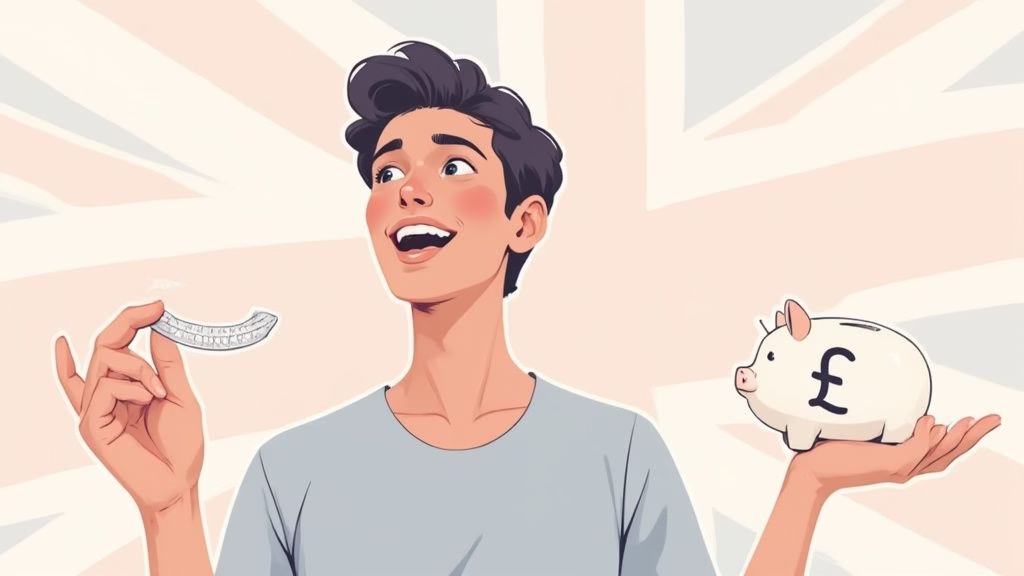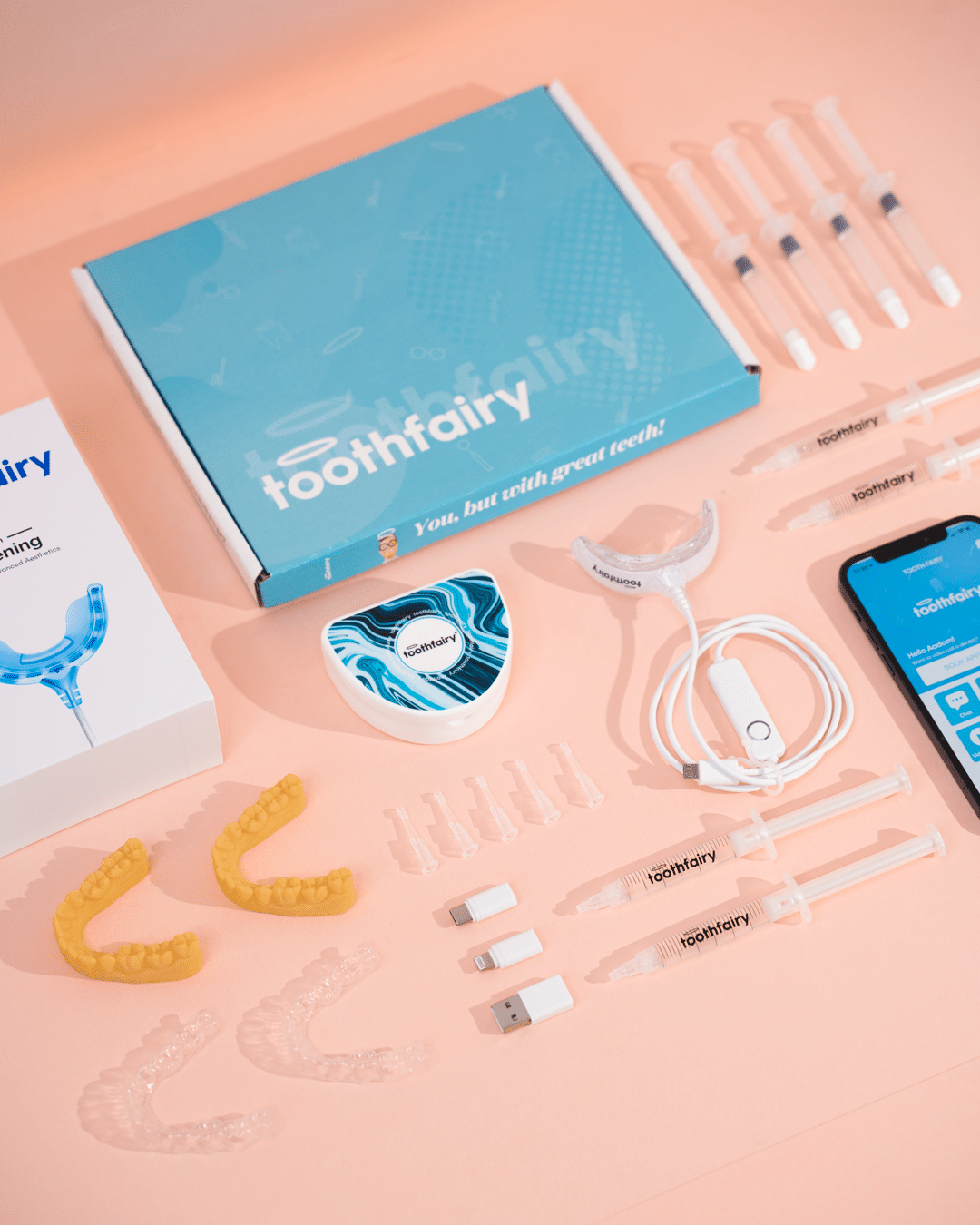What Is Fluoride Varnish and How Does It Work
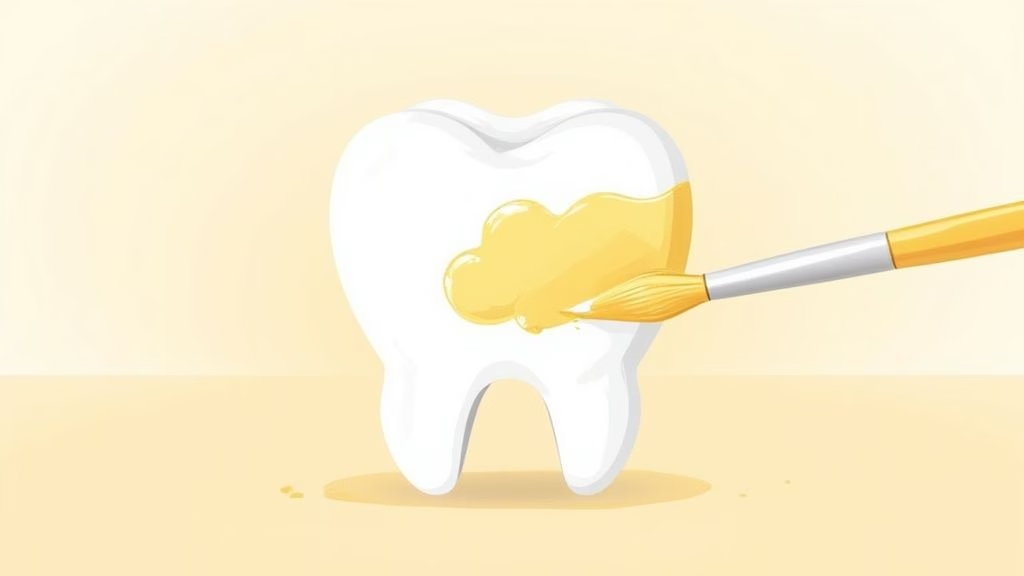
Ever heard your dentist mention fluoride varnish? It's a professional treatment where a highly concentrated fluoride gel gets painted right onto your teeth. Think of it less like a rinse and more like a super-protective, invisible shield for your tooth enamel.
What Exactly Is Fluoride Varnish?
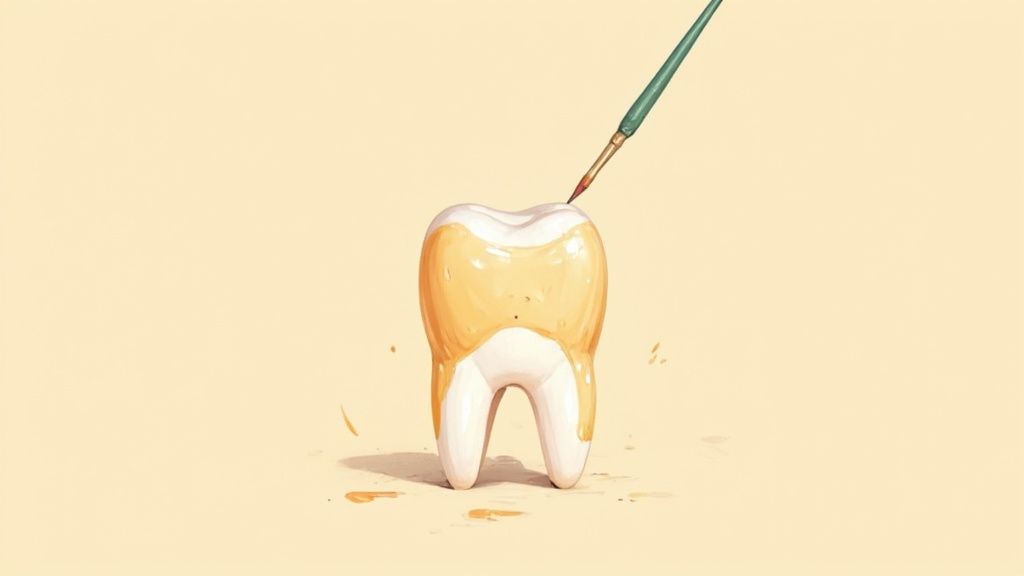
This sticky, often honey-coloured substance is a real game-changer in preventive dentistry. Its main job is simple but powerful: to strengthen your tooth enamel, making it much more resistant to the acid attacks that cause cavities. That’s why it’s a go-to treatment for kids and adults who might be at a higher risk of decay.
The best part? The application is incredibly quick and totally painless. Your dentist simply paints it on, and you're good to go.
How It Works Its Magic
What really sets fluoride varnish apart is its staying power. Unlike foams or rinses that are gone in a minute, the varnish's unique texture means it sticks to your teeth for hours. This prolonged contact time is key, as it allows your enamel to slowly soak up the fluoride, getting a continuous, high-powered dose of protection exactly where it's needed.
Think of it as a slow-release mineral pack for your teeth. It keeps working long after you’ve left the dental practice, constantly bathing your enamel in the good stuff to keep it strong.
To get a quick overview, here’s a simple breakdown of what fluoride varnish is all about.
Fluoride Varnish At A Glance
| Feature | Description |
|---|---|
| What It Is | A professional, highly concentrated fluoride treatment applied directly to teeth. |
| Appearance | Typically a sticky, honey-coloured or clear gel-like substance. |
| Primary Goal | To strengthen tooth enamel and prevent the formation of cavities. |
| Application | Painted onto the teeth with a small brush; quick and painless. |
| Key Advantage | Adheres to teeth for several hours, providing long-lasting, slow-release protection. |
This table sums it up nicely. It’s a straightforward but highly effective way to bolster your oral health.
Whether it’s giving your child's new teeth the best possible start or fortifying your own enamel before getting cosmetic work done, like clear aligners, knowing about fluoride varnish helps you make informed decisions. It's a foundational step towards a truly healthy smile.
How Fluoride Varnish Builds Stronger Teeth
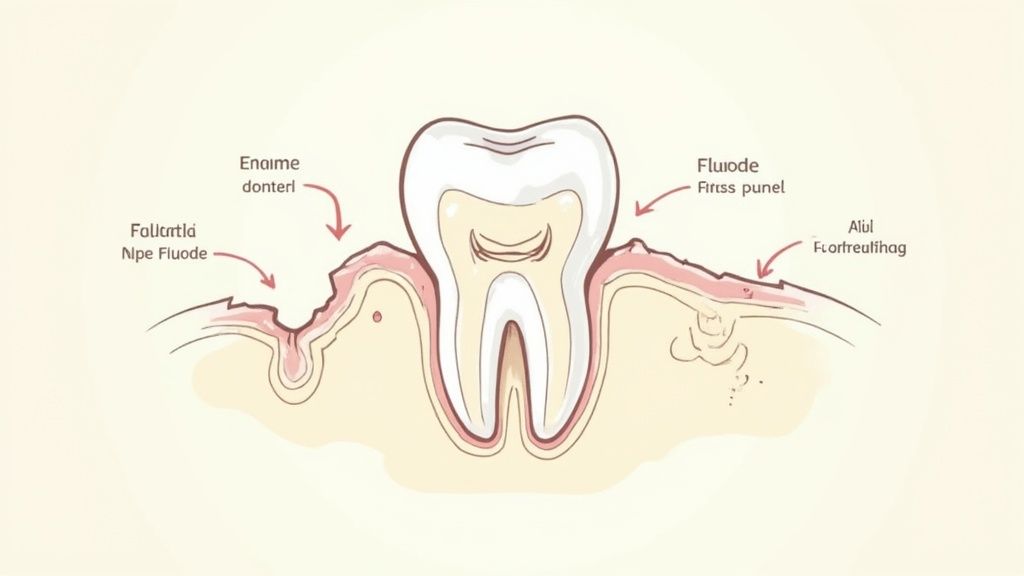
There’s a constant battle happening inside your mouth. Acids from food and plaque bacteria are always trying to steal minerals from your tooth enamel in a process called demineralisation. At the same time, your saliva is working hard to put those minerals back, a process known as remineralisation. Fluoride varnish is like bringing in elite reinforcements, giving your teeth the clear advantage.
Think of your tooth enamel as a fortress wall. Every day, it takes a bit of a battering. When a dentist paints on fluoride varnish, it creates a super-concentrated source of fluoride that stays stuck to your teeth for hours, continuously rebuilding and strengthening those walls.
This extended contact is what makes it so powerful. It gives your teeth a massive boost, turbo-charging the natural remineralisation process. But it doesn't just patch up the existing structure; it helps create a brand new, tougher surface mineral called fluorapatite.
The Power of Fluorapatite
This new fluorapatite layer is your smile's secret weapon. It’s significantly tougher and more resistant to acid attacks than the original hydroxyapatite that makes up your natural enamel. Essentially, you're upgrading your defences.
The research speaks for itself, showing that this fortified surface can cut the risk of new cavities by over 30% in children and adolescents.
You might notice that the varnish feels a bit sticky. That’s not a bug, it’s a feature! That stickiness is precisely what allows it to cling to your teeth and get the job done, ensuring maximum absorption of the fluoride ions.
Unlike a quick mouth rinse that's washed away in moments, the varnish’s staying power provides a continuous protective barrier that works for hours after you’ve left the dentist. This sustained delivery is what makes it so effective at preventing decay.
Whether you're looking to protect your child’s developing teeth or fortify your own enamel before cosmetic work, it’s helpful to understand what’s happening on a microscopic level. For example, building a strong foundation is vital before starting a treatment like clear aligners. A healthy, resilient enamel ensures you get the best possible outcome for your new smile.
Who Needs Fluoride Varnish? It's Not Just for Kids
When you hear "fluoride varnish," you probably picture a child in the dentist's chair. While it’s certainly a cornerstone of children's dentistry, its benefits reach far beyond the playground. Think of it as a powerful shield for anyone whose teeth are a bit more vulnerable to cavities, regardless of their age.

Of course, children are still the primary candidates. Their new adult teeth have just come through, and the enamel is still relatively soft and porous, making it an easy target for decay-causing bacteria. A quick, simple varnish application gives these young teeth a much-needed head start.
This is why it's a major focus for public health bodies across the UK. In Scotland, for instance, a targeted programme was put in place to get fluoride varnish to children in areas where the risk of decay is highest. During 2011-2012, 36% of four-year-olds in the most deprived communities received at least two applications. That’s a huge jump compared to just 6.1% in the least deprived areas, and it shows just how vital this treatment is for preventative care. You can read more about these public health findings to see the data for yourself.
Key Groups Who Should Seriously Consider Varnish
Once we move past childhood, certain health conditions and lifestyle factors can put adults squarely back in the high-risk category for decay. For these groups, fluoride varnish isn't just a good idea—it's essential protection.
- Adults with Dry Mouth: Saliva is your mouth's built-in rinsing and neutralising system. If certain medications or health issues are causing dry mouth, your teeth lose that natural defence and become much more susceptible to acid attacks.
- Anyone with Receding Gums: As gums pull back, they expose the root of the tooth. This part isn't covered by tough enamel; it’s a much softer material called cementum, which decays far more easily.
- Orthodontic Patients: Let's face it, cleaning around braces and other appliances is tricky. All those extra nooks and crannies are perfect hiding spots for plaque. A varnish treatment helps keep the enamel underneath strong and protected throughout your orthodontic journey.
Maintaining strong, healthy enamel is the foundation for any successful cosmetic journey. This preventive step ensures your teeth remain resilient, creating the perfect canvas for your ideal smile.
If you’re thinking about straightening your teeth, protecting your enamel is non-negotiable. Whether you're looking at traditional braces or a modern approach like Toothfairy, which offers a smarter way to straighten teeth than a specific aligner brand, starting with a strong, healthy foundation is critical. Fluoride varnish makes sure your enamel is fortified and ready for the amazing transformation ahead.
What to Expect During a Fluoride Varnish Application
If you’ve never had fluoride varnish applied, or if you're a parent bringing your child in for the first time, it's natural to have questions. The good news is that this is one of the quickest and most straightforward treatments we do. It’s completely painless and over in a flash.
The whole idea is to make it as comfortable as possible. Forget about drills or intimidating equipment; this is all about delivering powerful protection with a gentle touch.
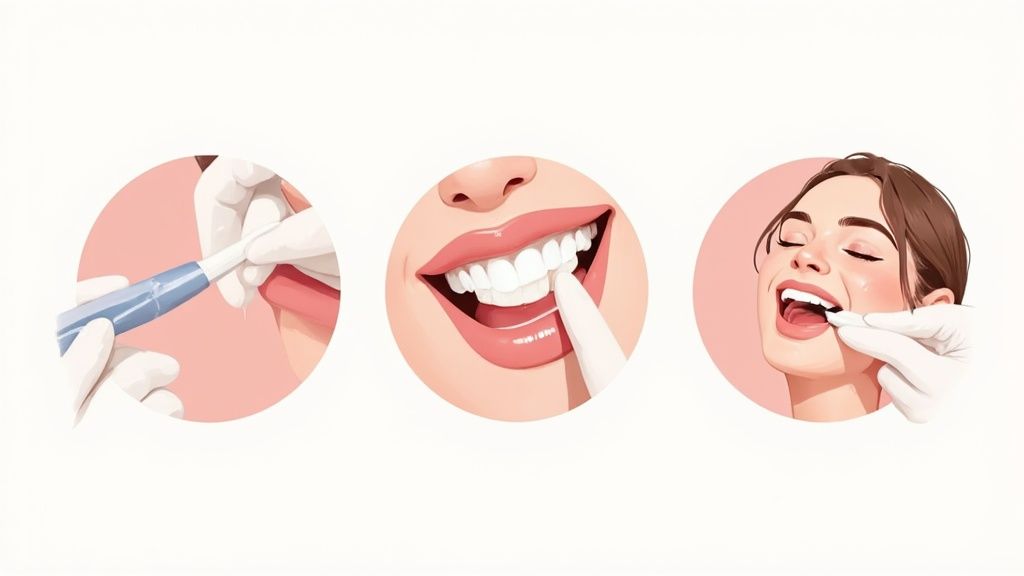
The Application Process Step by Step
Your dentist or hygienist will get the job done in just a few simple moves. Here’s a quick rundown of what happens:
- Drying the Teeth: First, we gently dry your teeth with a bit of cotton gauze or a puff of air. This is a key step because a dry surface helps the varnish stick properly, making sure it can get to work right away.
- Painting the Varnish: Using a tiny, soft brush, we'll "paint" a thin coating of the varnish onto all the surfaces of your teeth—front, back, and the chewing tops. It honestly just feels like having your teeth brushed.
- Letting it Set: The moment the varnish meets your saliva, it begins to harden. There’s no waiting around with awkward trays in your mouth. The entire process takes only a couple of minutes from start to finish.
Simple Aftercare for Maximum Benefit
To get the best possible results, you’ll need to follow a few easy instructions for the rest of the day.
The aim is to leave that protective varnish layer on for as long as possible. This gives your enamel plenty of time to soak up all that helpful fluoride, building a stronger shield against decay.
Your dentist will ask you to steer clear of hard foods, crunchy snacks, and hot drinks for at least 4-6 hours. You should also hold off on brushing and flossing until the next morning. It’s a small ask, but it makes a huge difference in how well the treatment works.
Right, let's talk about timing. When it comes to preventative treatments like fluoride varnish, how often you get it done really matters.
For most children, the standard advice here in the UK is to have it applied twice a year. We usually time this to coincide with their regular six-month check-ups, making it a simple and consistent part of their dental care routine. This steady top-up is fantastic for keeping their tooth enamel strong and resilient against decay.
But this isn't a hard and fast rule for everyone. Think of it more as a baseline. Your dentist will always look at your specific situation and might suggest a different schedule.
When Might You Need It More Often?
Sometimes, twice a year just isn't enough. If your teeth are facing a higher-than-usual risk of cavities, your dentist might recommend stepping up the applications to every three or four months. This gives your enamel an extra, much-needed shield when it's particularly vulnerable.
So, what puts you in this higher-risk category? It could be a few things:
- A history of cavities: If you or your child have had a lot of fillings in the past, more frequent varnish can help stop that pattern from repeating.
- Early signs of decay: Catching a weak spot early is key. Extra fluoride can often stop a potential cavity in its tracks and even help the tooth repair itself.
- Specific health conditions: Things like dry mouth (often a side effect of medication) or physical difficulties that make brushing tricky can dramatically increase your risk of decay.
Your dental plan should always be tailored to you. A good dentist will assess all these factors to figure out the perfect frequency for your fluoride varnish, giving you the best possible protection for your smile.
It’s worth noting that even with clear guidelines, not everyone keeps up with the recommended schedule. A study looking at NHS dental records was quite revealing; it found that over five years, only 3.5% of children had received ten or more applications by the time they turned 10. This is a real shame because it shows a big gap between the ideal protection and what's happening in practice. It really underlines why sticking to the schedule your dentist sets out is so important for keeping your teeth healthy for the long run. You can read more about the findings on fluoride varnish frequency.
Is Fluoride Varnish Safe? And What Does It Cost?
Whenever you're looking at a dental treatment, two questions naturally pop up: "Is it safe?" and "What's the damage to my wallet?" Let's put your mind at ease straight away. Fluoride varnish has the green light from health authorities all over the world and is considered one of the safest preventative treatments available.
A common worry, especially for parents, is about their child swallowing the fluoride. The good news is that the amount used in a single treatment is tiny. The varnish also has a clever trick up its sleeve – it hardens almost instantly the moment it touches saliva. This means the risk of swallowing any meaningful amount is incredibly low, making it a go-to choice for everyone from toddlers to adults.
An Affordable Way to Protect Your Smile
Here in the UK, fluoride varnish treatments are usually covered by the NHS for children, which is fantastic for ensuring kids get a great start with their dental health. For adults, it’s still a remarkably affordable way to invest in your long-term oral health, which fits perfectly with our mission at Toothfairy to make quality dental care accessible to all.
It’s a preventative step that parents really believe in. In fact, one UK study discovered that parents were willing to pay an average of £28.12 for the treatment for their child. This really shows how much they value its power to head off future dental issues. You can read more about the UK cost-benefit analysis of fluoride varnish if you'd like to dig into the details.
Think of it this way: a small investment in a fluoride varnish treatment today could save you from the cost and hassle of more complex procedures, like fillings or crowns, later on. It's a truly cost-effective strategy for keeping your smile healthy.
Your Fluoride Varnish Questions Answered
It's completely normal to have a few last-minute questions before trying a new dental treatment. Let's walk through some of the things people often ask about fluoride varnish, so you know exactly what to expect.
What Does Fluoride Varnish Taste Like?
Gone are the days of unpleasant-tasting dental treatments. Most modern fluoride varnishes are made with patient comfort in mind, often coming in mild, kid-friendly flavours like berry or mint.
You might notice a slight aftertaste from the varnish itself, but it's usually very subtle and fades quickly. The main thing you'll feel is a sticky coating on your teeth, which is a sign it's doing its job. This feeling disappears within a few hours as the fluoride gets to work strengthening your enamel.
What Can I Eat and Drink Afterwards?
Your dentist will give you precise instructions, but the general advice is to wait at least 30 minutes before having a drink and a good 4 to 6 hours before eating.
To get the best results, it’s wise to follow a few simple rules for the rest of the day:
- Stick to soft foods like soups, smoothies, or yoghurt.
- Steer clear of hot drinks and alcohol.
- Avoid anything hard, crunchy, or sticky that could disturb the varnish.
- Hold off on brushing and flossing until the next morning.
Following these steps gives the varnish the time it needs to seal onto your teeth and deliver its full protective power.
Think of it like this: you want to keep that protective layer on your teeth for as long as possible. This gives your enamel the maximum time to absorb the fluoride and build up its defences.
Knowing these little details helps you get the most from your treatment, setting you up for a stronger, healthier smile.
At Toothfairy, our mission is to make excellent dental care straightforward and accessible. Whether you're considering straightening your teeth affordably, need urgent advice for a dental emergency, or are curious about cosmetic dental work, we're here for you. Discover a better way to look after your dental health by visiting Toothfairy.
Last updated on October 23, 2025

Dr. Deepak
ToothFairy Care Team.
Dr. Deepak
ToothFairy Care Team.



